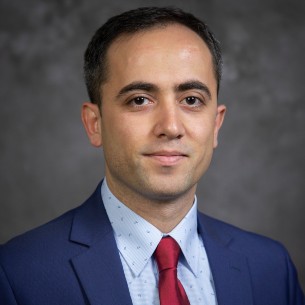 By Dawood Findakly, MD
By Dawood Findakly, MD
When consulted on patients, before learning their current status in the hospital, I examine the list of their medical conditions and review their present symptoms. During the physical examination, I look into their faces, trying to learn their expressions. This information is essential as it gives me a sense of who they are. Patients are human beings; they are not numbers in medical records or compelling cases to read about and treat. They are people with lives and families. As a physician, I engage patients and their families to facilitate a doctor-patient relationship that enhances patient outcomes.
An elderly man with a medical history of hearing impairment, prostate hyperplasia, chronic atrial fibrillation, chronic kidney disease, and a recent diagnosis of prostate cancer was brought unconscious to the emergency department (ED). He was found to have an acute kidney injury, which was later thought to be secondary to prostatic enlargement and a CT scan with intravenous contrast that he underwent a week before his current presentation. While I was rounding in the intensive care unit (ICU), I came across him. He was watched continuously inside a glass fishbowl room by medical personnel wearing masks and goggles. Because of the visitor restrictions prompted by the COVID-19 pandemic, his family was not permitted to visit him. Instead, an interdisciplinary care team arranged daily phone calls to update the family. Even while his mentation improved, he was still unwilling to communicate with the family, refused to eat, and deteriorated further. He needed a feeding tube placed to support his nutrition. Despite these interventions, he lost 40 pounds in 2 weeks. I distinctly remember when we called the family about his need for a percutaneous gastrostomy (PEG) tube placement, and the family was close to agreeing.
A Simple Idea With a Life-Changing Result
At that time, I thought deeply about the patient’s ailments, asking myself, “What am I missing here?” It seemed that he had lost his will to live, something that I could not directly relate to, but I could still feel what he was going through. I rely on my family’s support as I go through the hardships of medical residency. I can go home after my shift and talk to my family, and if I’m on a 24-hour long call, I still video chat with them and talk to my son. My patient did not have this privilege. It isn’t difficult to suppose that, in this situation, he might have felt abandoned by his family. Still, he was becoming debilitated to the degree that he did not want to interact with the medical team caring for him, and despite arranging phone calls with his close family members, he started to resist listening to them.
While the numbers on the chart improved for his laboratory studies and kidney function, his condition continued a steady decline. An ICU room is uncomfortable. My patient endured long sleepless nights, constantly beeping devices that he could not hear, but that bothered him with their flashing lights, wires hooked up to monitors, frequent blood draws, and nurses who kept coming in and out to administer medicines or replace treatment bags. He stopped asking for his hearing aid, which had barely helped him, as he still needed people to raise their voices and stay close to his ears to understand their speech—challenging to do in a mask and when you are trying to maintain distance for his own safety. Still, it was reasonable to consider a potential mental enigma in a vulnerable patient.
Hospitals are overwhelmed by the number of cases in the caveat of abruptly applied visitor restrictions without preparedness, attention, and resources. With limited hospital resources, video calls with family members were not an option for every patient, but rather only in particular cases where the family asked to see their loved one before making end-of-life decisions.
Yet, it was important for me to find out exactly what I could do to make something happen for this man. I really wanted to explore all options, and I knew I wanted to go further and beyond; therefore, I had an idea. I spoke with the family to gauge their opinion regarding bringing a device with video call capabilities to support him, motivate him to eat, and encourage his enthusiasm to live. The family welcomed the idea. Within an hour, they brought a tablet with a big screen, enclosed with new batteries for the hearing aid, and a photo of the whole family—which was dear to the patient—with a message on the back: “We love you, come back home.” They left these at the hospital entrance to be delivered to the patient’s room.
When I received the items the family sent for the patient, I hurried to his room, stepped in, and held the tablet close to his face with the volume raised to the maximum. In his bed, with eyes barely opening and tubes in his nose, I patted lightly on his shoulder to wake him up and directed his attention to the device in my hand. I felt his astonishment on seeing the familiar faces of his family. It was clear that this was not what he expected when considering the regular phone calls that he didn’t hear due to his hearing problem and the hearing aid that ran out of batteries for his lengthy admission. The sparkle in his eyes, the smile on his face, engraved with the lines of a long life, were frankly telling; the people in front of him on the screen were his whole world, the family waiting for him outside the walls of his small room without a view. I watched them use simple gestures, imitating how he needed to eat, and how they need him back home. It was evident that that small screen was not only a small screen; I felt it became a real-world experience for him. He then tried to hold the device in his hands. I replaced the batteries for his hearing aid and set the tablet on the table close to the food plate.
Within the next 10 minutes, the patient ate his first meal consisting of Jell-O, ice chips, and mashed potatoes. The family asked to continue to video chat with him at each mealtime. In the next couple of days, the patient was transferred out of the ICU to the medicine floor and later discharged home.
Upon following up with him before discharge, he had more power to talk and move. He relayed to me that he thought his family abandoned him to an institution, and he didn’t want to live a life like that, confined to those four walls by himself. He left the hospital without feeding tubes (and, more importantly, without a PEG tube in his stomach). He walked out of the hospital with a big smile on his face, knowing that he would find his family beyond that main hospital door.
What Do Patients Need: The Effect of Connecting Hospitalized Patients With Loved Ones During Times of Social Distancing
As of early July, the COVID-19 pandemic has resulted in around 2.9 million reported cases and over 131,000 deaths in the United States, numbers that continue to rise exponentially. The rapid transformation of the health care system during the pandemic has taken a toll on delivering and maintaining quality health care and practice of medicine for hospitalized patients. Moreover, amid this pandemic, caring for patients is becoming more complicated due to the restrictions on visitation. Loved ones are unable to visit and provide emotional support to patients; patients don’t feel the family’s support as before due to their severed communication. Physicians and health care professionals feel the stress of providing excellent medical care to their patients when the hospital is at capacity while having the additional task of keeping the family updated and involved from a distance. In the interim, patients start feeling that their relatives have given up upon them, and these thoughts might impact their willingness to live.
Additionally, some patients can’t express what they want and who they want to talk to in this situation. Their emotions are already overwhelmed by their conditions, not to mention their isolation from the outside world.
We need a permanent solution to this problem via working on all aspects of patients’ care together with empathy and compassion. Hospitals have rallied to increase the availability of resources for patients and their families to decrease the burden and intercept the chain of events on patients experiencing stressful conditions, hopelessness, and helplessness. So, let us all stand together to promote connection for healing, and continue to advocate and support our patients and their families through this arduous time.
Dr. Findakly is currently an internal medicine resident at Creighton University School of Medicine (Phoenix Program). Follow him on Twitter @dawood_findakly. Email him with any questions at dawood.findakly@gmail.com.


Recent posts